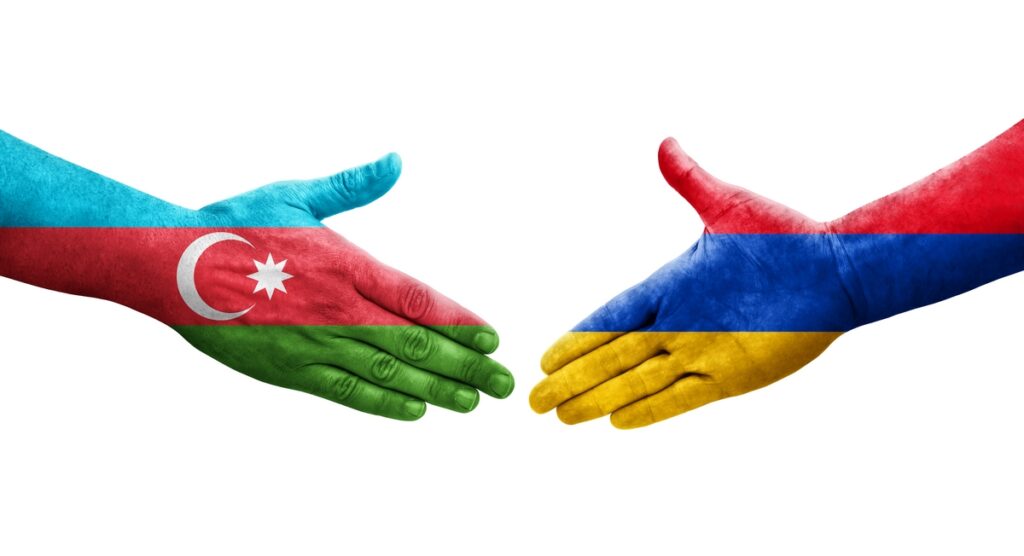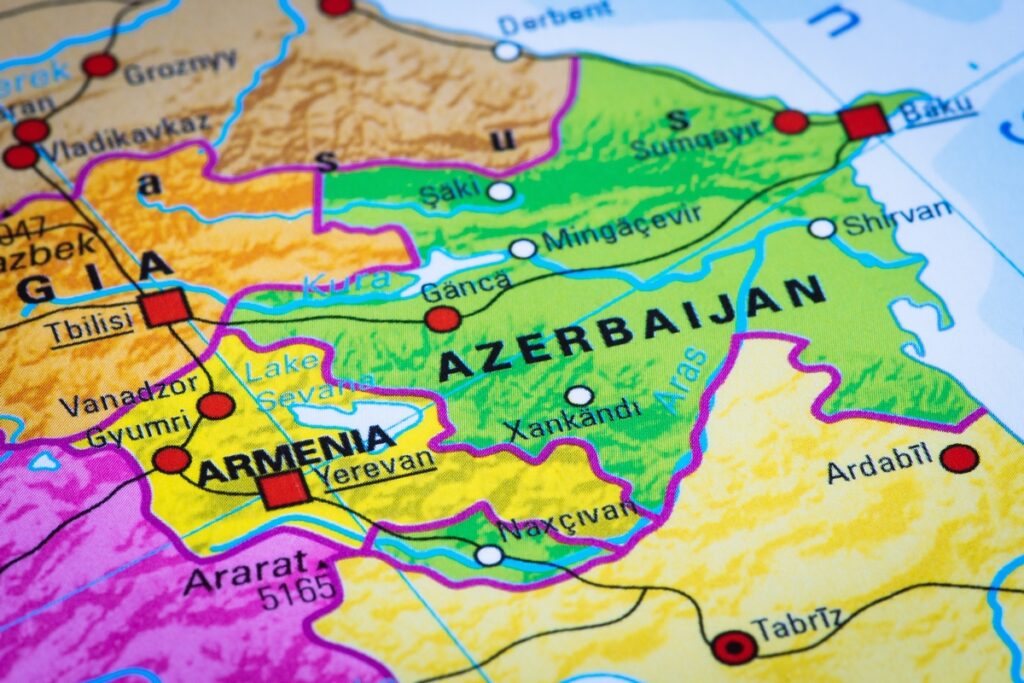A region weighing peace, sovereignty and new connections

ANALYSIS
by Žikica Milošević
After decades of conflict, blockades and wars, it seems that Armenia and Azerbaijan have finally reached a point where peace is no longer just a diplomatic phrase, but a strategic necessity. Both countries are exhausted, the region has changed, and the major powers — Russia, Turkey, Iran and the West — now share a common interest: a stable South Caucasus. Within this puzzle, the key element is the so-called Zangezur Corridor – a proposed road and railway route that would connect mainland Azerbaijan with its exclave of Nakhchivan, passing through southern Armenia.
Peace is no longer just a diplomatic phrase, but a strategic necessity
However, the story began long ago, and there are many “stakeholders”, as one would say in a managerial SWOT analysis. Once upon a time, three empires ruled here: the Persian Empire, which held what is today Armenia and Azerbaijan; and the Ottoman Empire, which controlled everything from Circassia to Georgia. Later, as both weakened, the third one – the Russian Empire – took over the entire area from each of the previous two. It also inherited the challenges of ethnic and religious diversity, which the USSR tried to manage — more or less successfully — until it collapsed, after which we once again had the three principal “stakeholders”. And then a fourth, the United States, which, since 1945 and the end of isolationism, has regarded “the whole world as its backyard”. Trump may be somewhat more inclined towards isolationism and the pursuit of peace agreements in the hope of winning the Nobel Prize he desires. Still, the US is very much present — the spirit of Empire is always hovering nearby.
To keep the historical account brief: after the First World War, Armenia was larger and even had access to the sea, thanks to the efforts of Woodrow Wilson, which is why the first post-imperial republic is often referred to as “Wilsonian Armenia”. In the USSR, due to Armenia’s pro-Western political leaning, Azerbaijan ended up in a more favourable position. It received the Nagorno-Karabakh Autonomous Region, which Armenians predominantly populate. The rise of nationalism in the Caucasus led to sharp polarisation, ethnic conflict and declarations of the abolition of autonomy and secession, all of which culminated in war between Armenia and Azerbaijan. Armenia achieved a major victory, seizing as much as 40% of Azerbaijan’s territory, far beyond the borders of Karabakh. They proudly referred to themselves as the “Israelis of the Caucasus”, capable of defeating a much stronger opponent.
Things did not turn out that way. Oil- and gas-rich Azerbaijan built diplomatic networks everywhere — from Turkey and Russia to Israel and the United States — while Armenia drifted, often quarrelling in recent years with its only real ally, Russia. The Armenian government became openly anti-Russian and pro-Western, irritating the Kremlin. It was expected, as in the case of (now North) Macedonia, that the large influx of wealthy Armenian emigrants — as happened with Jews in Israel or Lebanese returnees — would bring enormous capital into Armenia and create a “Swiss Caucasus”. That never materialised: the Armenian diaspora kept its money abroad, Azerbaijan grew stronger, and regained everything.
And once Karabakh also came under Baku’s control, the question emerged of how to reach the Nakhchivan region, the Azerbaijani exclave separated from mainland Azerbaijan by only a narrow stretch of Armenian territory. Was force an option? Some wondered. Such a move would cut Iran off from access to the Black Sea, making it unlikely that Tehran would stand aside. For Armenia, it would sever the route toward the Persian Gulf. And with Armenia’s quarrel with Russia and withdrawal from the CSTO, Moscow would no longer be obliged to defend anyone who attacked Armenia, nor any other member would. The proposed way out of this stalemate? A corridor. And not just any corridor.

Zangezur Corridor – A Path to Peace or a Highway Through Tension
The idea of the Zangezur Corridor is not new. During Soviet times, a railway passed through the Syunik (Zangezur) region. Today, the corridor symbolizes both potential regional connectivity and deep geopolitical tension. For Azerbaijan, it represents an “artery of the future” — a direct link to Turkey and Europe without crossing Iran. For Armenia, it feels like a “knife to the throat”, threatening territorial continuity and sovereignty. For Iran, it is a question of prestige and security, as Tehran fears losing control of its northern route and its access to Yerevan. The challenge, therefore, is to combine infrastructure with sovereignty without humiliating any side.
One emerging idea proposes a “highway on pillars” — an elevated Azerbaijani route connecting to Nakhchivan, under international supervision, while Armenia’s existing road network would continue below, with tangential roads (like Italian “tangenzionale” roads) linking Syunik’s towns and villages. Beneath both could run an Iranian highway from Tabriz to Yerevan, preserving regional continuity and avoiding isolation.
Such multi-layered coexistence is not unprecedented: Europe already hosts complex infrastructural overlaps, from Italian viaducts to Swiss tunnels crossing delicate borders. In the Caucasus, this would symbolize bridges instead of divisions — concrete pillars standing for balance between sovereignty and cooperation.
Diplomatic efforts are moving in this direction. Armenian PM Nikol Pashinyan and Azerbaijani President Ilham Aliyev, with EU mediation, are discussing border recognition and transport reopening. Though technical details remain open, control, security and transit mechanisms will be decisive. One concept envisions neutral monitoring, perhaps under EU or UN mandate, ensuring Armenia’s sovereignty while guaranteeing Azerbaijan’s secure access to Nakhchivan.
Meanwhile, Western investors are showing interest in renewing rail and road links connecting Baku, Nakhchivan, Iğdır, Kars and Yerevan, extending toward Georgia and the Black Sea — forming a commercial arc between the Caspian and the Mediterranean. Even Iran could benefit by joining a wider transit network uniting Tehran, Yerevan, Tbilisi and Baku with Europe. If peace truly materializes, the Zangezur project could become a “peace in concrete” — a physical manifestation of reconciliation, where roads and railways replace trenches. Rather than a highway “across someone else’s land”, it could stand as a bridge between historical wounds and shared futures. Perhaps one day, its pillars rising above the Caucasus will symbolize what once seemed impossible: the South Caucasus as a crossroads of peace, not conflict.
Nationalism Is an Expensive Sport
Nationalism has already cost the Caucasus dearly. And it is not new at all. It first emerged in 1988 between the Azeris and Armenians, and Mikhail Gorbachev did not dare to intervene. It reappeared when the constitution of the new Union of Sovereign States was being ratified, rather than that of the USSR. Armenia and Georgia (except Abkhazia and South Ossetia) boycotted the referendum. Azerbaijan did not. When the dust settled, Georgia paid the price through civil war and the secession or de facto independence of three regions (Abkhazia, South Ossetia and Adjara – the latter was later returned peacefully), as well as another war in 2008. Armenia eventually lost Nagorno-Karabakh, while Azerbaijan, the only loyal one to the USSR and to a carefully balanced policy among all major actors, regained its territorial integrity after years and years of attempts to restore control over the entire territory.
Bridges instead of trenches, roads instead of divisions
Nationalism was also costly for Chechnya – it was destroyed to its foundations, only to become, in peacetime, a republic with Grozny-City, vast parks, mosques and a semi-sharia system in the sense that alcohol is prohibited except in hotels. Nationalism came at a high price for Moldova too – two regions broke away: Gagauzia (later reintegrated peacefully) and Transnistria. It is now costing both Ukraine and Russia. Religious fanaticism cost Tajikistan a civil war that spilt over from the Tajik part of Afghanistan. Uzbekistan was wise – the secessionist region of Karakalpakstan was not attacked militarily until a settlement was reached, which remains in effect today. Kazakh diplomats say they were so shocked by the violence of the Gorbachev era that they resolved never to solve anything through nationalism or force. And they are doing very well now. It cost Serbia, Bosnia and Herzegovina, Croatia and Kosovo, which has gained a “state” from which, statistically, the highest number of people in the world emigrate, and which will soon be nearly empty beneath its proud blue and yellow flags.
Perhaps it is time we abandon toxic nationalism for good, both in the Balkans and in the Caucasus, two powder kegs. Perhaps it is time to open borders again, to trade, to travel, to spend our summers freely. Perhaps it is time again for tours like those of the Putnik agency in 1988 – the ones I begged my father to take me on as a child – to Tbilisi, Yerevan, and Baku. A great deal of tolerance, patience and conscious repression of trauma will be needed for this to happen. In theory, the border between the two countries should be open, allowing displaced people to return and regain the rights they held in the USSR, while remaining loyal citizens of the republic in which they reside, preserving the culture of their own ethnic heritage. This is not so difficult in the digital age.
It becomes difficult only if we allow our deep, primal urges to prevail. Yet let us try to imagine a new and better Caucasus. Perhaps even one with those highways, one above the other.